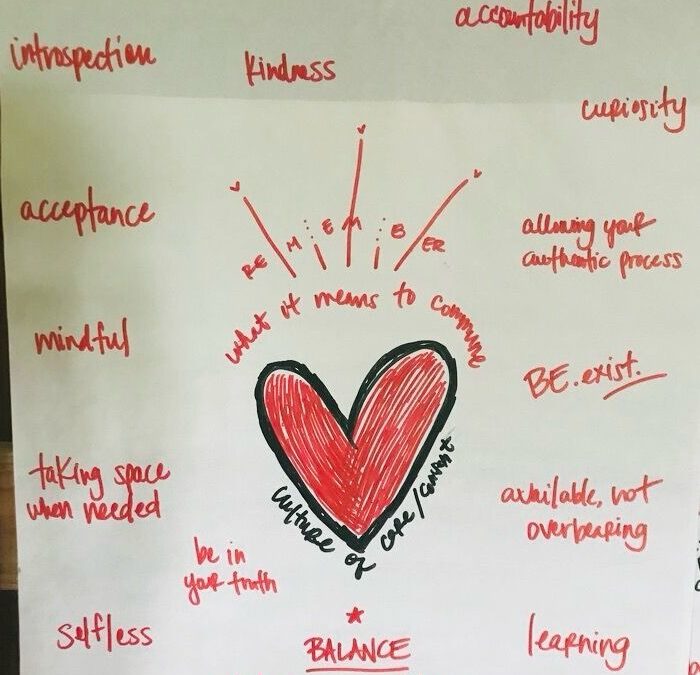
by Cortina Jenelle | Oct 17, 2023 | business, creative coach, entrepreneur coach, leadership coach
Back when I was still in corporate, I gave some serious thought to potentially going the Human Resource route. Besides loving fixing systemic inefficiencies, one of my other favorite to-dos on the job was the training component. Still to this day, I’m mind boggled at why companies don’t have more robust training and professional development budgets for their people. The places that invested in me as a professional quite honestly, got more of my loyalty and time.
It seems like common sense to me, but I guess I could also understand the line of thinking that has people thinking that increased support for professional development leads to higher turnover rates, but honestly I just haven’t seen that that study actually exists anywhere. In fact, you’re more likely to find the opposite to be true – people stay where they’re happiest.
Back in 2016, I had the honor of being selected to present/speak at IDEATE as part of the NCSHRM State Council conference in Asheville, NC. The theme was “Lead Differently” and we challenged human resource professionals and other business leaders to rethink how they engage and motivate staff and colleagues. Here’s my talk in full from the way-back time machine:
https://youtu.be/z5-5JbWvh9Y
Takeaways?
– Authenticity matters. Principle-led leaders want to be in principle-led spaces.
– Invest in your people. It’s a REALLY smart way to make sure you see a longer sustaining ROI in the long-term and it ripples out into their families, neighborhoods, communities, schools and the whole ecosystem is better for it.
– Consider beefing up your professional development budget, or hey! Make one.

by Cortina Jenelle | Sep 12, 2023 | blog, creative coach, deib, entrepreneur coach, facilitation, sacred heart
Culture of care is often something I talk about in my work with young professionals, students, community partners and clients. It seems like more and more, these concepts need to be brought to the forefront in team spaces because it’s not standard for us these days. But, is there a such thing as too much compassion or empathy? In my DEIB work especially, people are concerned with where to draw the line about triggers and how to respond to conflict. It’s not always easy to track the ROI of human relations where we work and learn. But the lack of care in any space certainly be felt.
I have a proposition for you.
What if you proactively, or as soon as you can, establish some parameters and agreements for creating and sustaining a culture of care at your job, project or school? Meaning, the work and the mission is important but not at the expense of leaving people behind or sacrificing their well-being to get there.
Not having a true culture of care costs us good people, takes more time (spent on putting out little fires, addressing conflict or violations) and less time is spent on the actual work anyways so why not create a clear container so that people feel seen, heard, valued and respected. This leads to a clear path to express our boundaries, needs and discomforts *without* making someone also the scapegoat to fix it.
Is this something you could imagine using, or have used in your work or learning spaces?
Food for thought!

by Cortina Jenelle | Aug 8, 2023 | blog, business, creative coach, entrepreneur coach, entrepreneurs, facilitation
The digital age has redefined how we work, learn, and connect. In response to recent global challenges, the embrace of remote work, virtual meetings, and online learning has only grown stronger, shaping new paradigms for the modern professional – with no slowing down in sight. As a freelancer over everything and an introverted processor, I have been working remotely for nearly 10 years. Tools like Asana, Slack, Google Suite, Honeybook and LinkedIN were my go to’s early on in 2013 and I cannot begin to tell you how excited I am to witness the roster of tools growing With these changes come distinct trends that are molding our digital experiences.
Hybrid work models are becoming the new norm, with companies permitting employees to enjoy a blend of office and remote work. Online learning platforms are integrating game mechanics to keep engagement high and enhance retention, a phenomenon known as gamified learning. Meanwhile, virtual and augmented reality are no longer just buzzwords or some “out there” concept, they are beginning to create immersive meeting and learning experiences that captivate and inspire.
Accessible Options for Remote Work + Virtual Meetings:
- Airtable: A blend of spreadsheet and database, it offers dynamic ways to organize content, track tasks, and manage projects.
- Google Meet: Integrated with other Google services for reliable video conferencing.
- Microsoft Teams: Your one-stop hub for collaboration, including chat, video meetings, and file storage.
- Slack: Messaging made simple and efficient for teams with channels and integrations.
- Trello: Visualize your tasks and projects with its unique board and card system.
- Moodle: An open-source Learning Management System tailored for the educators of today.
- Kahoot!: Learning meets fun with this game-based platform, perfect for quizzes and interactive sessions.
- Miro: Brainstorm and collaborate with this digital whiteboard tool.
- Notion: An all-encompassing workspace platform that goes beyond just notes and tasks.
- Discord: From gamers to study groups, a platform to build and nurture communities.
The modern era, marked by its rapid digital evolution, emphasizes the significance of staying connected, informed and adaptable. That in mind, it’s important to make sure that any platform you use, especially if a requirement for your team or workplace, is inclusive and accessible for everyone. All the platforms I name above are FREE to use and offer a lot of functionality even with no payment requirement. The more you upgrade, the more robust your features are so that’s fun too!
Harnessing the power of digital tools not only ensures smooth communication but also fosters growth, innovation, and unity in both professional and personal spheres. Whether you’re a digital novice or a seasoned tech enthusiast, these platforms and trends are pivotal in crafting a connected and efficient future. If nothing else, I’m absolutely excited about the time freedom I earn when I can train these digital tools to keep me organized + connected.
Happy relating!
Photo by Chris Montgomery on Unsplash

by Cortina Jenelle | Nov 4, 2022 | blog, business, creative coach, entrepreneur coach, entrepreneurs, imagination, sovereignty
Business insurance is an essential tool for building wealth and protecting the assets of a company. In today’s unpredictable business environment, it is crucial to have a safety net in place to protect against unexpected events that could otherwise lead to financial loss and bankruptcy. In this article, we will explore how business insurance can help build wealth and provide peace of mind for business owners. Over the last seven years, following the sudden loss of my father, I have become more educated on the necessities and opportunities with insurance. Since he didn’t have any that we know of, there were no assets and no wealth to leave behind. In his honor, I vowed to not make the same mistake and to educate others on financial health and the stable investment into insurance.
I was surprised to find that many people are more consistent with their auto insurance payment than their life insurance premiums. Why? Simply a focus on other priorities and lack of education is my guess. So I decided to focus somewhere in the middle and help other entrepreneurs and small business owners protect their assets (i.e. property, equipment, themselves, etc) so that all of the sacrifices they’re making today are not in vain tomorrow should something unexpected happen.
This is where we begin to see opportunities to build wealth.
First, let’s take a look at the role of business insurance in protecting against risk. Risk is an inevitable part of doing business, but with proper insurance coverage, the financial impact of these risks can be mitigated. For example, a company that experiences a fire or natural disaster could be faced with significant financial losses if they are not insured. Business insurance can cover these losses and provide financial stability during a time of crisis.
Another way in which business insurance can help build wealth is by providing liability protection. Liability insurance can protect a business from lawsuits and other legal actions brought against it. This protection is especially important for companies that deal with customers or clients, as it can help mitigate the financial impact of lawsuits and other legal actions.
In addition to risk protection and liability coverage, business insurance can also provide access to a range of benefits that can help companies grow and thrive. For example, some insurance policies offer coverage for lost income, which can help businesses keep their doors open during difficult times. Business insurance can also provide coverage for employee benefits, such as health insurance and retirement plans, which can attract and retain high-quality employees.
Research supports the importance of business insurance in building wealth. A study by the National Association of Insurance Commissioners found that companies with insurance coverage were less likely to experience financial difficulties than those without insurance (NAIC, 2016). Another study by the Insurance Information Institute found that small businesses that invested in insurance had a higher success rate and were more likely to survive long-term than those without insurance (III, 2018).
In conclusion, business insurance is a valuable tool for building wealth and protecting the assets of a company. It provides protection against risk, liability, and access to a range of benefits that can help companies grow and thrive. By investing in business insurance, business owners can have peace of mind and feel confident in their ability to weather any storm that may come their way.
Photo by Med Badr Chemmaoui on Unsplash
References:
NAIC (National Association of Insurance Commissioners). (2016). The Role of Insurance in the Economy. Retrieved from https://www.naic.org/prod_serv/economic_research_role_of_insurance.htm
III (Insurance Information Institute). (2018). The Benefits of Business Insurance. Retrieved from https://www.iii.org/article/the-benefits-of-business-insurance




